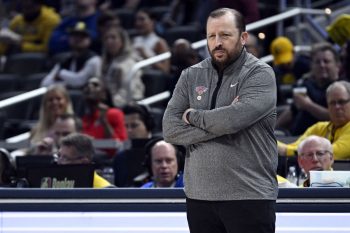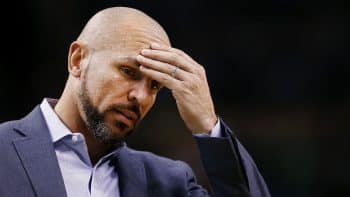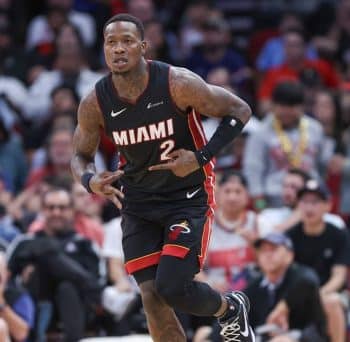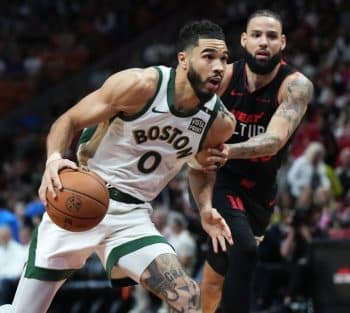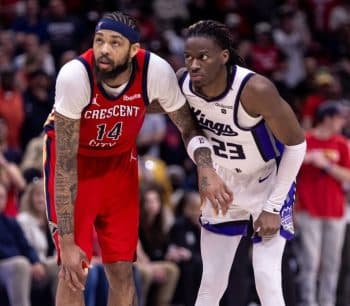NBA
Knicks Need to Limit Carmelo Anthony’s Minutes

The Knicks finished the 2013-14 season with a terribly disappointing 37-45 record. However, they may not have been quite as bad as their record suggests. New York was competitive in many losses, losing nine of the ten games they played that were decided by three points or less. And that total doesn’t include three other games they lost in overtime.
If their best player, and one of the game’s greatest scorers, was able to knock down a few more jumpers, the Knicks’ 2013-14 campaign might have had a different feel.
Carmelo Anthony posted incredibly impressive individual statistics last season. Melo became the first player in over a decade to average at least 27 points, eight rebounds and three assists per game throughout a full NBA season. He was also remarkably efficient on the offensive end of the floor. In fact, he became just the fourth player in NBA history to average over 27 points a night while shooting above 45 percent from the floor, 40 percent from the field and 82 percent from the free-throw stripe. The other three members of that incredibly exclusive club are Larry Bird, Michael Jordan and Kevin Durant.
Anthony essentially carried the Knicks on his back for the better part of five months. Unfortunately, for the both the Knicks and Anthony, this added responsibility often resulted in weary legs and misfired FG attempts when the Knicks needed them most.
Last season, Anthony was 0-of-8 in the last ten seconds of games that were within three points; shockingly, he was just 1-of-16 in the final 30 seconds.
This was surprising because over the first eight years of his career, Anthony had developed a reputation as one of the NBA’s most clutch players. He knocked down more game-winners than any player not named Kobe Bryant.
Per ESPN Stats and Info, from 2010 thru 2012, in clutch situations (with ten seconds or less in the fourth quarter or overtime when trailing by one possession or tied) Anthony was 8-for-15 from the floor, including going 5-for-10 with the Knicks. No one had more makes than Anthony’s eight, and his 53.3 field goal percentage on those shots was the best among 16 players with at least 10 late-and-close attempts.
Many pundits have posited that the most likely cause of Anthony’s inability to knock down late-game jumpers was the excessive energy he had to exert just to keep the Knicks in games last season.
Anthony has always logged a heavy workload, but last year was exceedingly taxing. Former head coach Mike Woodson, desperate to save his job, rode Anthony relentlessly. He led the NBA in minutes played, averaging nearly 39 minutes a night. And it’s not solely the sheer volume of minutes that was distressing; the Knicks leaned heavily on Anthony whenever he was on the floor. He’s always been the focal point of New York’s offensive attack, and in recent seasons he’s also been forced to guard bigger and stronger power forwards on a nightly basis.
Last season Anthony became just the second player, age 29 or older, since 2010 to log over 3,000 minutes in one season. The only other player to have matched that feat is Kobe Bryant, who played 3,000+ minutes in 2012-13. (As we know, Bryant tore his Achilles in April of 2013 and managed to play a total of just six games in 2013-14 before a knee injury ended his season).
Over the summer, the Knicks handed Anthony a massive new contract in order to keep him in New York. Phil Jackson and company made a $124 million investment in Anthony. Limiting his minutes on a per-game basis will not only increase the likelihood of the Anthony being more effective and efficient in the clutch throughout the 2014-15 campaign, it will also increase the probability of staying healthy throughout the life of his five-year contract.
Moreover, the numbers clearly indicate that an exhausted Anthony, is a less efficient Anthony.
Last season (per BasketballReference.com), in games in which he played between 20 and 29 minutes (four games), Anthony shot 53.8 percent from the floor in those contests.
In games in which he played between 30 and 39 minutes (40 games), Anthony shot 46.8 percent from the floor.
In games in which he played over 40 minutes, Anthony shot 43.1 percent from floor.
The correlation here is obvious.
The challenge for new coach Derek Fisher will be resisting the urge to lean too heavily on his best player.
Unfortunately, the Knicks don’t have much proven depth behind Anthony at the small forward spot. How much trust does Fisher have in rookie Cleanthony Early? Travis Outlaw, whom the Knick obtained in a trade this summer, has been invisible this preseason and may not even make the opening night roster. Might Fisher choose to go small and consider playing two wings alongside a point guard? Possibly slotting Iman Shumpert and J.R. Smith beside Jose Calderon or Pablo Prigioni? Tim Hardaway Jr, who Phil Jackson recently stated is actually measuring in at 6’8” could also see some minutes at small forward as well. Another option could be going the opposite direction and utilizing big combinations up front by mixing-and-matching Samuel Dalembert, Amar’e Stoudemire, Jason Smith, Andreas Bargnani, Cole Aldrich, and/or Quincy Acy.
One way or the other, Fisher and the Knicks have to keep the big picture in mind, which means making sure Anthony is well rested by any means necessary. Keeping him fresh is imperative because it not increases the chances of Knicks finding success late in games this season, but also increases the odds the team’s best and highest paid player stays healthy and productive long-term.
